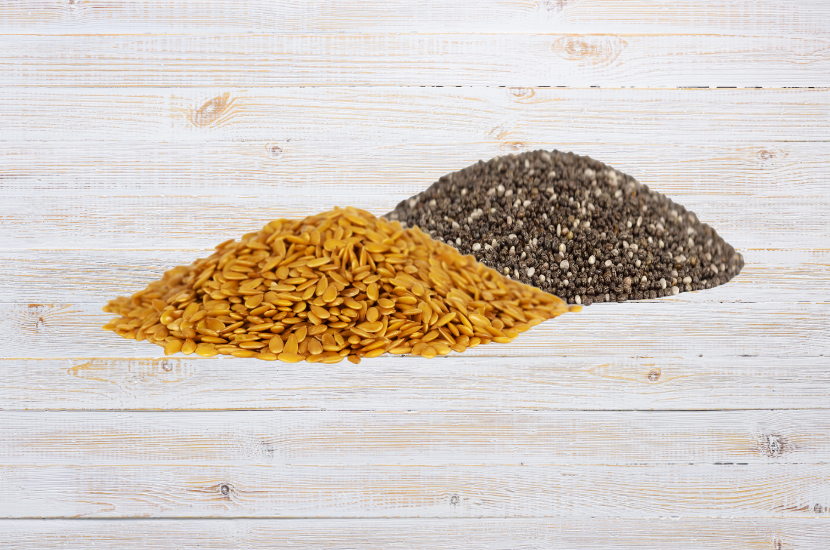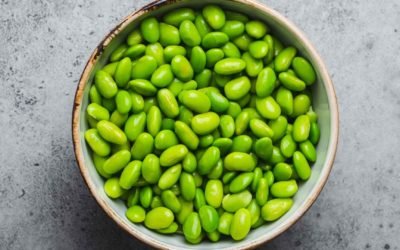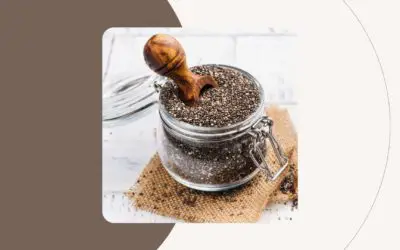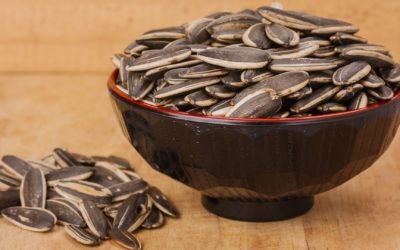
A Comparison Of Chia Seeds and Flax Seeds: Health Benefits and Uses
Chia seeds and flax seeds are two of the most popular seeds that even though are small in size, but packs a punch full of nutrients. These small powerhouses are both great sources of fiber, protein and they both share the same health benefits of lower blood sugar levels and they promote cardiovascular health. Hence, what are the health differences between them? This article seeks to address this pertinent question.
Origins
Chia seeds are a famous superfood known for being high in fiber, protein, and omega-3 fatty acids. Chia seeds come from the regions of Mexico and Guatemala and are an important diet for the Mayan’s and the Aztec’s. It is said that chia seeds were regarded as even more precious than gold.
Flax seeds, also known as linseeds are slightly bigger seeds that have a similar shape to pumpkin seeds. They are usually brown or golden and these seeds have a long history. Their usage can be traced back 3000 BC, in Babylon where it was said that King Charlemagne had ordered all of the citizens to consume flaxseeds for their health benefits. Flax seeds come from the plant, Linum usitatissimum and they are native to the Middle East’s Fertile Crescent.
Here is the nutritional information of chia seeds per 28 g:
Calories: 486
Protein: 16.54 g
Fat: 32.1 g
Carbohydrates: 42.12 g
Fiber: 34.4 g
Omega-3 fatty acids: 17,500 mg
Potassium: 407 mg
Iron: 7.72 mg
Calcium: 631 mg
Phosphorous: 860 mg
Magnesium: 335 mg
Copper: 0.92 mg
Manganese: 2.72mg
Here is the nutritional information of flax seeds per 100 g:
Calories: 534
Protein: 18.29 g
Fat: 42.9 g
Carbohydrates: 28.88 g
Fiber: 27.3 g
Omega-3 fatty acids: 22, 857.1 mg
Potassium: 813 mg
Iron: 5.73 mg
Calcium: 255 mg
Phosphorous: 642 mg
Magnesium: 392 mg
Copper: 1.22 mg
Manganese: 2.48 mg
Differences
From the nutritional information list of both seeds, we can see that flax seeds contain higher amounts of protein and omega-3 fatty acids. Proteins are amino acids that help to build and repair muscles and bones. They are also involved with hormonal and enzymatic activity. Flax seeds also contain larger amounts of copper and potassium. Copper is one of the elements needed to form red blood cells and it supports iron absorption. Potassium is needed to prevent loss of muscle mass and the formation of kidney stones.
As for chia seeds, they contain fewer calories, more fiber and more iron. They also contain much more calcium and phosphorous, the two bone related minerals.
Effects on reducing risk of heart illness
Both types of seeds may reduce the risk of developing heart illness, due to the high amounts of Alpha-Linolenic acid (ALA), which is a plant-based omega-3 fat. 100 g flax seeds contain 22, 857.1 mg of omega-3 fatty acid which is more than 17,500 mg found in 100 g of chia seeds, and hence flax seeds are the winners of this category. However, the amount of omega-3 fatty acids in chia seeds are not to be underestimated as they are still a lot as compared to salmon which only has 4000mg of omega-3 fatty acids per 100 g of salmon. ALA helps to lower the risk of heart attacks and illnesses due to the effects of lowering blood pressure and cholesterol levels. Hence, both chia seeds and flax seeds help to lower blood pressure and cholesterol levels although more research is needed for the effect of chia seeds on the latter.
Effects on reducing risk of cancer
Both seeds contain high amounts of fiber which are especially helpful in reducing the risk of developing colon and breast cancer. Both seeds are also rich in antioxidants that help to prevent cell damage related to cancer. However, flax seeds have higher levels of antioxidants – they contain 15 times more lignans (which are a cancer-fighting antioxidant) than chia seeds. A research involving 6000 women showed that consuming flax seeds regularly could reduce the risk of developing breast cancer by 18%. Hence flax seeds are more effective in reducing the risk of developing cancer.
Effects on blood sugar levels
Both seeds have high amounts of fiber which may help to convert glucose into carbohydrates that are absorbed more slowly into the body. This helps to keep blood sugar levels more constant and therefore, benefit people with type-2 diabetes. Studies have shown that people with type-2 diabetes who are fed flax seed powder everyday could have reduced their fasting sugar by 8-20%. Consuming bread with may also lead to smaller spikes in blood sugar levels than consuming just plain breads. Hence, flax seeds and chia seeds both help to maintain blood sugar levels at a constant level.
Effects on digestion and constipation
Fiber aids in digestion as they are a form of prebiotic, which forms during the fermentation process with the aid of healthy bacteria in the colon. The overall product helps to line the colon and aid in digestion. Soluble fiber helps in reducing diarrhoea as soluble fiber forms a sticky gel-like mixture which helps to glue undigested food together to prevent watery stools. Insoluble fiber on the other hand, acts a laxative to facilitate bowel movement, therefore reducing constipation. Chia seeds contain more fiber than flax seeds and the advice is to drink more water when consuming large amounts of flax seeds as they could cause intestinal blockage.
Effect on curbing appetite
Flax seeds may be more effective at curbing appetite, as 40% of their fiber are soluble as compared to the 5% of fiber in chia seeds. When fiber is soluble, they form a sticky consistency which increases the feelings of fullness, therefore reducing appetite. The soluble fibers also triggers the release of hormones that controls hunger, further curbing appetite. Hence, both types of seeds help to control appetite, although more so for flax seeds. Greater research also has to be done exploring the relationship between chia seeds and appetite.
Uses of chia seeds and flax seeds
As they are small, they are highly versatile and can be added to just about anything; your soups, puddings, smoothies, yoghurt, breakfast cereal and sandwiches etc. The differences are that chia seeds do not need to be smashed and they can be eaten whole. However, flax seeds may need to be grounded as their shells are hard to be digested and you will not be able to reap their nutritional benefits. Flax seeds are more suited for baking and making biscuits as they have a nutty flavour. Flax seeds can also be used as substitute for eggs. Simply add one tablespoon of ground flax seeds with three tablespoons of cold water. They will turn into a gelatinous substance that can replace eggs as an ingredient in your baking.
Chia seeds are often added onto wet food such as porridge, drinks, and muesli as they balloon up after 15 minutes when in contact with water and take on a gelatinous appearance. The wet gel like chia seeds are better digestible than dry ones and you may be able to reap their benefits more when you allow them to absorb more moisture. You may also check out our ways to use chia seed where we incorporate chia seeds into our bakes and popsicles!
Conclusion
All in all, chia seeds and flax seeds are superfoods that have similar effects, although flax seeds are effective to a larger extent. They both contain high amounts of protein, fiber and healthy fats required for heart health, reduction of cancer risks, weight loss and an overall quality of life!






